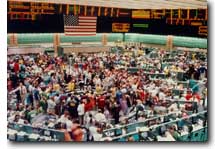IN THIS SECTION:
Introduction | Futures Contracts | Options on Futures Contracts | Prerequisites For Futures and Options on Futures Markets | Contract Innovations | A Comparison Of Futures, Equities, Forwards and Over-the-Counter Derivatives
Contract Innovations
 The futures industry has a long history of product innovation. Corn, wheat, and cotton trading dates from the post-Civil War period in the United States. Metals trading began in the 1920s, while refined agricultural products--soybean meal and oil--became available in the early 1950s. A new wave of innovation began in the 1960s when futures on a perishable commodity--livestock--were first introduced.
The futures industry has a long history of product innovation. Corn, wheat, and cotton trading dates from the post-Civil War period in the United States. Metals trading began in the 1920s, while refined agricultural products--soybean meal and oil--became available in the early 1950s. A new wave of innovation began in the 1960s when futures on a perishable commodity--livestock--were first introduced.
In 1972, following the demise of the Bretton Woods system of fixed exchange rates, the financial futures era began with the introduction of futures contracts on foreign currencies. With the legalization of private ownership of gold by U.S. citizens at the end of 1974, gold futures commenced trading. As interest rates became more volatile, futures exchanges introduced interest rate futures, beginning in 1975 with the GNMA contract based on a pool of mortgages. The following year three-month Treasury-bill futures were introduced, and in 1977 the very popular Treasury-bond futures contract debuted. Energy futures trading in the United States dates from the 1978 inauguration of heating oil futures. Following the weakening of OPEC's control over the global oil market, other successful petroleum-based futures, most notably crude oil and gasoline contracts, were introduced.
All these relatively recent futures contracts adopted and adapted the delivery mechanism designed for grain and cotton trading developed in the mid-1800s. That delivery mechanism assured price convergence between the expiring futures contract and the underlying cash market, thereby validating futures contracts as hedging instruments. In 1981, Eurodollar futures became the first futures contract that did not require delivery. Instead, the contract called for settlement in cash, in effect a payment on the last trading day of the difference between a reputable, independent and widely accepted cash price and the futures price. The cash-settlement innovation safeguarded the futures contract's usefulness to hedgers and opened the way for new types of contracts on which a delivery option would be impossible or prohibitively expensive; most notable among these are stock index futures, which began trading in 1982. That same year options on futures were reintroduced after a 50-year ban in the United States.
The mid- to late-1980s also were a period of phenomenal international growth of Futures and Options on Futures Markets, as numerous new exchanges opened throughout the world. While these exchanges offer a range of contracts, their most successful products fall into three broad categories modeled on the innovative contracts introduced in Chicago from 1977 to 1982--futures and options on futures on government bonds, short-term interbank interest rates and stock indexes. The U.S. prototypes of these successful global contracts are the U.S. Treasury bond, Eurodollar, and S&P 500 stock index futures and options on futures.



